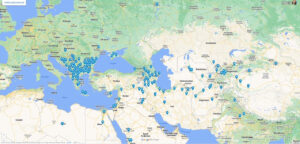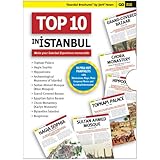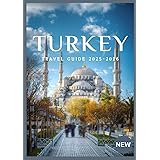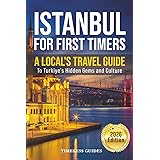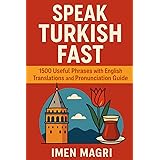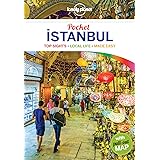On the Great Wall of China, April 1997
Levent Ağaoğlu [1]
From the Great Wall of China to Rumelia
I sacrifice to my
noble ancestors
From the Mediterranean to
the Pacific!
A spark is enough for
my beloved nation.
April 1997, Hong Kong
CONTENTS
- Conceptual Renewal
- Concepts of Imperial Strategyupdate
- “Greater Middle East” Strategy Concept
- Strategic Concept of “Greater Mediterranean” (Asian Mediterranean)
- Atlanticism, Eurasianism, Mediterraneanism
- Ports, rivers, caravan-transport routes of the Greater Mediterranean
- Silk Road
- “Turkestan was the heart of the world economy in history”
- “Our most valuable underground resource is our saintly sages lying in Turkestan lands”
- “A Mediterranean stretches all the way to the Chinese border”
- Mediterranean World and Turkic Republics
- Old Mediterranean – New Mediterranean
- Turkish Poetry
- Levend’nâme Great Mediterranean in Poems
- Mediterranean and Turks
- Can the Turks realise a union in the Mediterranean
- Why the Mediterranean?
- Greater Mediterranean Union
- Mediterranean
- Countries of the Greater Mediterranean Union
- France’s Greater Mediterranean Union initiative
- Mediterranean Writings
- Conclusion
************************************************
Conceptual Renewal
1 While Asia-Pacific concept is valid why not Asia-Mediterranean becomes valid as well?
2 While Central Asia concept is valid why not Turk-Asia and Asia-Turk concepts become valid as well?
3 While Five Eyes concept is valid why not Turkish Eyes become valid as well?
4 While Greater Middle East concept is valid why not Greater Mediterranean concept becomes valid as well?
5 The World of Çelebis. Why not?
From scratch with new concepts…
CONCEPTS OF IMPERIAL STRATEGY
The term Eurasia is a concept invented by German strategists (1858). The
term “Middle East” is an imperial concept invented by the British (1850) and
the term “Greater Middle East” is an imperial concept invented by the
Americans (1943). These imperial powers, who have no historical background
and historical depths in the regions in question, sew a dress like a clamp in
which the people of the region cannot move. However, the concept of the
Mediterranean has been used since the 7th century. The imperial powers have
devalued a 1300-year-old concept and polluted a region that is not theirs with a
fabricated military terminology.
A concept and definition without philosophical and historical depth is not
objective, it is hollow. The concept of the Greater Middle East is designed as
an ideological concept based on religion and therefore divisive (sects, cults).
However, the concept of the Mediterranean means the Middle World and is a
unifying concept that increases interaction and co-operation. It reflects the
unifying philosophy of the Roman Empire.
GREAT MIDDLE EAST STRATEGY CONCEPT/PROJECT
The GMEP project, which the “divide and rule” strategists tried to dictate
especially after the Second World War, is a mandate administration. Turks are
neighbouring Russia to the north through Turkey, India to the south through
Turkestan and China to the east. Our preference for transatlantic allies instead
of neighbouring countries is forced and tragic.
It has been more than 30 years since we left the race of progress that we
started to catch up with the late Özal. After the 1974 Cyprus landings, just as
we were prevented by civil war rehearsals, the same rehearsals were put on
stage after Özal’s death (1993), and we were distanced from the European
target and eventually turned into a GMEP country in the Middle East. Among the
three eastern alternatives (Eastern Europe, Eastern Asia, Middle East), we
chose the Greater Middle East.
In June 2001, when I was returning to Turkey after a 4.5-year stay in Hong
Kong, the United States had abandoned the Greater China policy and
restarted the Greater Middle East policy with Bush Jr. We are a wing country
again. GMEP is a project of the Atlantic power.
In the second half of the 1960s, US journalist (!) C.L.Sulzberger published two
articles on the Turks.
First, the article “Russia, China and the Turks” in the New York Times of 26
November 1965. [2]
GREATER MEDITERRANEAN (ASIA MEDITERRANEAN) STRATEGIC CONCEPT/PROJECT
On 15 August 1968, Sulzberger published the article “The Great Turk” in
Cumhuriyet newspaper, praising the “Turks from the Adriatic to the China
Sea”. Sulzberger shows the direction that our founder indicated as the
Mediterranean Sea as the China Sea.
“It would be useful to reconsider the Asian qualities of the Turk. The ancient
Turks, who advanced with heavy and sure steps from Mongolia to Austria,
crushing the closed societies in their path and cracking horses under saddles,
always looked in the direction they were going, always to the West. Apart from
all these, the departed Turks left unforgettable memories for their compatriots
who remained in China and Russia. The days will come when Turkism will
regain its strength and its culture will spread. Of course, this will not happen
tomorrow. Just like the emergence of Chinese bogeymen which frightens the
long-term planners. But if these planners will continue to make calculations
on Asia for the next century, they should not forget the presence of the
Great Turk in Asia.” [3]
While both articles published by Sulzberger clearly show the US perspective on
the Turks in the Greater Middle East policy, on the other hand, by mentioning
the Turks in Russia and China and assuming that they may be a threat to the
US, Sulzberger seems to have demonstrated his far-sightedness, taking into
account the developments in the first quarter of the 21st century. Turkey, which
is being squeezed by the US from the west through Greece and from the south
through Syria, is now looking for ways out against this hostile behaviour of its
so-called ally.
GMU, the Greater Mediterranean Project, is a Turkish project from the Pacific
to the Mediterranean. It is important that the institutional and technical
infrastructure of GMU is prepared and the project becomes functional. In the
Greater Mediterranean geography of the Turks, there is no country where
their language, population and influence are not present.
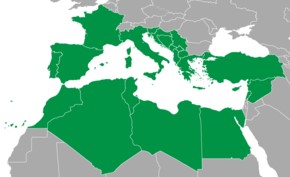
Mediterranean Countries
The term “Greater Mediterranean” is a Turkish concept. Turks have thousands
of years of history and historical depth in the proposed region. In this respect, it
is essential to transform the Mediterranean, surrounded by three continents,
and the Turkestan region, surrounded by India, Pakistan, Afghanistan, China,
Russia, Azerbaijan and Iran, into a synergetic power through the Silk Road
and the Spice Road. As the great poet Nazim Hikmet expressed in his lines
“Galloping in from Far Asia,
Stretching like a mare’s head to the Mediterranean
This country is ours.
Asia in the context of Turkestan, Turkey as a mare’s head and the
Mediterranean, which are expressed in the verses, have a unity.
Leaving behind the 100th anniversary of the Republic, Turkey, as the
founding initiative of the Organisation of Turkic States, should bring up a
dynamic cooperation project that the countries of the Organisation can
develop with the Mediterranean countries and launch the Greater
Mediterranean Union (GMU) initiative, the antidote to the GMEP. In 2021,
although the Organisation of Turkic States was established, this organisation is
based on a limited geography of Turkey and Turkestan countries, the
integration and diversity of the Greater Mediterranean (Mediterranean
countries, Turkey, Turkestan and Khorasan) should be activated. What is
important is that Turkey’s Greater Mediterranean vision should be decided
and realised. There is no such vision yet.
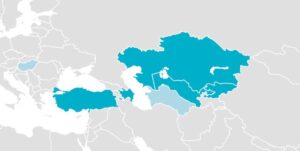
Countries of the Organisation of Turkic States
It should not be forgotten that 70% of the Silk Road route passes through
Turkestan countries.[4] Moreover, Turkey is the country with the longest coast
to the Mediterranean Sea. In history, the destinations of the Silk Road caravans
departing from Turkestan have always been Mediterranean ports.
Our duty is not to translate and use the “divide and rule” style strategic
concepts of the imperial powers such as Middle East, Greater Middle East
etc. into our language, but to place our concepts from our history at the centre
of our strategy by leaving these garbage concepts out of use. For example,
these seas surrounding us such as the Mediterranean Sea, the Black Sea, the
Red Sea and the Gokce Sea are all expressed in colours and have deep
meanings.
The Mediterranean is also a geopolitical and political concept. The Great
Mediterranean instead of the Greater Middle East. The continuation of “Your
first target is the Mediterranean!” strategic target. Of course, there is no political leader who can articulate this.
With the concept of the Greater Mediterranean, the Mediterranean expands
eastwards to the Great Wall of China. The Great Wall is like the Berlin Wall; a
world of prohibitions.
“Greater Mediterraneanism” against Atlanticism and American, Russian
and Chinese Eurasianism. Turkey, which is besieged by the USA with the
Greater Middle East Project (GMEP), especially from the West and South,
will be able to find its way out through the Greater Mediterranean Project.
ASIA-MEDITERRANEAN
The concept of Asia Pacific is associated with the Pacific Ocean on the eastern
coast of Asia and the continents of North America, South America and
Australia beyond. At the western end of Asia is the Mediterranean Sea,
which is also associated with the continents of Europe, Asia and Africa along
these coasts. International trade between China and America, which are
located on opposite coasts of the ocean, ranks first in world trade.
However, no concept has yet been produced about the connection of the Asian continent with the Mediterranean.
Here we can propose the concept of Asian Mediterranean. The geopolitics we call Asia Mediterranean is actually a much more strategic geography than Asia Pacific. The five seas, straits, canals and islands located here make the Mediterranean, which means the centre of the world, unique. Turkestan and Turkey, which are included in the concept of the Greater Mediterranean geopolitics, are all in transition zones; transition from China to Europe, transition from Asia to Europe, transition from Asia to Africa.
Trade between China and the US in the Asia Pacific region is the world’s
largest trade. In the same way, Mediterranean trade through Turkey and
Turkestan trade through Turkey have the capacity to grow to gigantic
dimensions. In particular, the natural resources of the Turkestan region and
the markets of the Mediterranean region reveal the opportunity to re-stage a
model similar to China’s exchanges with the countries of the Asia Pacific
region in the Mediterranean.
ATLANTICISM, EURASIANISM, MEDITERRANEANISM
While Atlanticism seems to be an Anglo-Saxon strategy, especially through
the GMEP project to control the Mediterranean Sea and NATO strategy to
control the Black Sea and the Arctic Ocean, Eurasianism seems to be a
German-Russian co-production. The German policy of opening to the east is
trying to expand on the axis of Russia and Turkey. Russia, on the other hand,
strongly defends its Eurasian strategy as it has territories in both Europe and
Asia and the largest surface area in the world.
The critical point here is that Atlanticists and Eurasianists have no coastal
links with the Mediterranean and Africa; both currents are completely extraregional forces.
As a result, when we analyse the strategy of the Mediterraneans, we can
see that only France has had a failed attempt that did not yield any results.
The only advantageous country here is Turkey. Turkey, which has the longest
coasts in the Mediterranean, has been present in Asia, Europe and Africa in
the past centuries. The Turkish population, especially in north Africa and the
Balkans in south-eastern Europe, has the necessary conditions for a regional
union based on the Turkish language and Turkish culture. By giving a
bipartite structure to the Greater Mediterranean Union, Turkey can implement
a model in both Turkestan and Mediterranean countries and initiate a
vibrant and dynamic regionalisation development.
In what way can we attempt a regional union with the countries in the
Atlantic where we have no coasts? However, our country, which has the
longest shores of the Mediterranean, can realise this potential with the
vitalisation of the Organisation of Turkic States and can bring the
landlocked Turkestan countries to the sea and give them a magnificent
vision extending to the Mediterranean through Turkey.
Firstly, the Atlanticists continuously blocked Turkey’s accession to the
European Union and then the US positioned Turkey in the Greater Middle East
Project. Since the beginning of the 21st century, Turkey is now a Greater
Middle East country and co-chair of the project. The legal infrastructure has
also been changed in this way. The presidential system is a GMEP
implementation. In case Turkey joins the European Union, the enormous
power that the union will gain is perceived as a threat by the USA. This is
because Turkey is located in a geopolitical position that can be strategically
effective on both the European and Asian continents. In this case, what
Turkey should do is to implement its own regionalisation project through a
Great Mediterranean Union that includes all three continents. Here,
instead of the divide and rule policy imposed by the USA through religion, the
regionalisation project should be implemented as soon as possible with an
interactive dynamic from east to west and from west to east in areas
extending from the “Mediterranean to the Great Wall of China” through
language.
TWO-PART “GREAT MEDITERRANEAN” CONCEPT DESIGN
Five of the 26 thinkers in the fresco of the School of Athens, designed under
the leadership of the Vatican, were born in Turkey.
- Homer
- Diogenes
- Anaxagoras
- Anaximander
- Heraclitus
In the fresco of the School of Athens [5] The unity of the Catholic Church,
which ideologically fragmented the Mediterranean, with the concept design of
the “Greater Mediterranean”, a “Lost Enlightenment” that extends to the
borders of the Great Wall of China when the Khorasan and Turkestan
geographies that fall within the sphere of influence of the Mediterranean are
added. [6] will start to resurface.
The “Great Mediterranean” is in two parts. 1 Classical, old Mediterranean. 2
Turkestan and Khorasan geographies. Turkey, which “stretches out like a
mare’s head to the Mediterranean”, and the integrity of the Great
Mediterranean formed by Turkestan and Khorasan geographies surrounded by
oases, is a platform of enlightenment together with its thinkers. These thinkers
take us on a journey along the shores of our Great Mediterranean Civilisation,
like all the waves that arise from the Mediterranean and gain momentum.
The Atlantic Mind [7] It dismembered the region in order to take it under its
sovereignty and used the terms used in military terminology such as Middle
East etc. to generalise the region it dismembered. The Greater Middle East
Project is a project that does not belong to us. Our future will be shaped by our
actions in the geography represented by the Great Mediterranean map.
Just as the Mediterranean Sea is surrounded by three continents (Asia,
Europe, Africa), Turkey is big in Europe, Asia, Africa and all three continents.
Turkey is the power in the north of Africa, in the south-east of Europe, in the
interior, west and centre of Asia. Rather than calling these regions by
geographical names such as the Balkans, the Caucasus and Central Asia, it is
of utmost importance that we use the political concept of Turkey.
The Mediterranean, marginalised as the Middle East, is the Middle World
when subjected to an objective and accurate reading. This is the etymological
meaning of Mediterrane. In the Middle World, all directions come together.
Inner Asia (Turkestan), which is located on the Silk Road route, is also a
Mediterranean-style organisation from history, together with its oases.
In the 21st century, the two Mediterranean regions, the Mediterranean Basin
(Mediterranea) and the Silk Road (Turkestan), are uniting around the concept
of the “Greater Mediterranean”. Mediterranean countries (including
Turkey), Turkestan countries and the countries of the historical Khorasan
region together show a view of a Fertile Crescent.
Despite the Western Atlantic powers that created the concepts of Central Asia
and the Middle East in the 19th and 20th centuries in line with their own
interests, the ancient reality of thousands of years since ancient times is the
Mediterranean and the region called Central Asia is Turkestan.
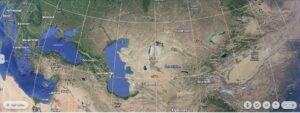
Fertile Crescent (Mediterranean, Turkey, Turkestan, Khorasan)
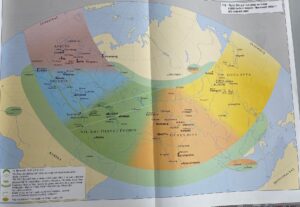
The “Fertile Crescent” of the scientific and writing cultures of the ancient world (3000 BC-AD 2000) Source: Elmar Holenstein, Atlas of Philosophy
PORTS, RIVERS, CARAVAN-TRANSPORT ROUTES OF THE GREATER MEDITERRANEAN
The Danube, the Adriatic coast, the Mediterranean, the Sea of Islands, the
Ionian Sea, the Ionian Sea, the Black Sea coast, the Nile, the Eastern
Mediterranean, the cities and harbours of the Levant and North Africa, the
Euphrates and Tigris rivers in Syria and Iraq, The coasts of the Caspian Sea,
the coasts of the Maveraunnehir (Seyhun, Ceyhun), the coasts of the Persian
Gulf, the oasis cities in East Turkistan, the cities and settlements on the banks
of the Yenisei, Orkhun, Selenga, Tola rivers are the areas where the Great
Mediterranean phenomenon is in question.
The shores of the Great Mediterranean, the centre of the world, are
surrounded by harbours overflowing with ideas and commodities; Istanbul,
Troy, Miletus, Pergamon, Halicarnassus, Athens, Thessaloniki, Izmir, Ephesus,
Rome, Barcelona, Beirut, Piraeus, Alexandria, Kyrenia, Magosa, Paphos,
Haifa, Tripoli, Casablanca, Tunisia, Algeria, Assos, Haifa, Jaffa, Jaffa, Alanya,
Alexandria, Latakia, Tartus are the cities where great thinkers were raised.
Homer, Diagones Laertius, Thales, Anaximander, Heraclitus, Anaxagoras,
Sheik Edebali, Nasrettin Hodja, Yunus Emre, Aşık Pasha living in Turkey,
Aristotle, Plato, Socrates, Parmenides, Protagoras, Pythagoras living in
Greece, Laozi, Abu Hanifa, Bilge Tonyukuk, Bilge Kagan, Farabi, Maturidi,
Kashgarli Mahmud living in Turkistan, Yusuf Has Hacip, Ahmed Yassawi and
wise thinkers such as Harezmi, Biruni, Ibn Sina, NizamülMülk, Ghazali, Hacı
Bektaşı Veli, Mevlana living in the Khorasan geography are the witnesses of
the Great Mediterranean concept that have left deep traces in this world, they
are the pioneering sparkles, treasures of light of the Great Mediterranean
Civilisation emerging from the Mediterranean Basin.
The Mediterranean Basin is an Atlas of Thought, the world’s most
comprehensive Encyclopaedia of Thinkers; it is the homeland of philosophy.
The firsts article of the encyclopaedia is one of the most crowded articles. The
first philosophy in Athens and Miletus, the first library in Alexandria and
Pergamon, the first Christianity in Antakya and Tarsus, the first sociology in
Tunisia, the first roots of the modern alphabet in Phoenicians, the civilisations
of Asia Minor, Ancient Egypt, Ancient Greece and Crete, and the Andalusian
Civilisation have all come to life on these shores.
The islands, peninsulas, rivers, mountains, inland seas, harbours, basins,
straits, gulfs and canals surrounding the Mediterranean Sea have led to the
emergence of the most influential ideas and thinkers in this most interactive
piece of geography.
THE SILK ROAD
All innovations (paper, printing press, gunpowder, compass) were carried to
Europe from Greater Asia via the Silk Road, and the Iron Silk Road, which will
be operational from 2035 onwards, will integrate the “Great Mediterranean”.
While Asia Minor Turkey was being woven with railways in the 1935s, a century
later, the 2035s will be the beginning of a new era, the Silk Road Age, in which
Greater Asia will connect the Oceans by railways.
The intellectual riches that started with Tonyukuk the Wise in the Yunzhong
Çuğay mountains along the 41st parallel at the starting point of the Silk
(Wisdom) Road and described as Mediterranean Civilisation with Yahya
Kemal Beyatlı in Rumelia via Yusuf Has Hacip (Turkistan), Yesevi Ahmet (Piri
Turkistan), Hacı Bektaşı Veli, Yunus Emre (Diyarı Rum) will be blended again
in the Mediterranean Pot.
The Silk Road, Turkestan, Maveraunnehir, Khorasan, Mesopotamia, Asia
Minor (Anatolia) and North Africa are the functional units of the “Great
Mediterranean Union”.
“THE HEART OF THE WORLD ECONOMY IN HISTORY WAS TURKESTAN”
“The heart of the world economy in history was Turkestan. Economic
historians formed this sentence in the 1970-80s. Their justification was this,
they said: “When is the history of the world economy?” Is this famous debate
500 years old? Is the history of the world economy 5000 years old or 50,000
years old? In the middle of that debate, some economists said: Archaeological
data, findings, etc. show us that there has been an integrated world
economy for at least 5000 years.
Where is this place, through which line, the line connecting China and
Europe, and where is the heart of this line, the heart of this line is
Turkestan.
Whenever there are strong states in Turkestan, there is a world
economy, whenever there is instability and conflict in Turkestan, the
world economy stops.
That’s why, for example, cities like F are the New York of the period,
that is, there are people of all nationalities. They came there to trade, they
exchanged with each other, very proud and very rich.” Prof Dr Mehmet Akif
Okur [8]
Turkestan is a geographically catalysing region. Turkestan synthesises all
aspects within itself, including India, China, Islam, which came to the region
from the west, Tengricism, Shamanism and Zoroastrianism. All these religions
reach a synthesis in Turkestan; “Our most valuable underground resource
is our saintly sages lying in the lands of Turkestan”
- Greater Asia and Turkestan are strategic geographical nomenclatures
- instead of Eurasia and Central Asia, which are British-Russian coproductions.
- Great Britain and Russia, hand in hand, transformed the term Turkestan into Central Asia with the Great Game.
- Greater Asia again. Turkestan again.
A MEDITERRANEAN SEA STRETCHES TO THE CHINESE BORDER
“Tuula Romagnoli[9] He was one of the Italians I knew best and he talks
about a Mediterranean Sea. One end of this Mediterranean is here, the
other end is Iran and it goes all the way from Asia to the borders of China,
and we should not forget this. The culture and structure of this world
depends on this, there is no Third World-type colonialist legacy here, people
are open to the world in various languages and in various ways. We can never
say that the intellectuals here are mono-coloured and unipolar, neither their
conservatism nor their openness to the world. Just as ambassadors were
exchanged between Spain and Iran, in the 11th and 12th centuries,
ambassadors from the provinces around Barcelona travelled to Timur, and this
is also true for the Turkic world.” İlber Ortaylı [10]
MEDITERRANEAN WORLD AND TURKIC REPUBLICS
“The Mediterranean World is an indivisible part of the world, and there is
no doubt that Turkey has always been a central link within that part. No
matter how much you may want to give importance to Spanish in universities
or education, people apply to the Cervantes Institute in large numbers and
the demands continue to be met. Because people are looking for a relationship
with their surroundings in a country like Turkey. The ignorance and irrelevance
of the state and political parties in these matters is none of our business.
You cannot prevent immigrants from coming to this country from these
countries. Today, our working mothers find the best opportunities for their
children not in expensive kindergartens and primary schools, but in carers from
our eastern republics, who are not the type of carers we are used to. In every
university, especially in the newly established ones, I have to look for
mathematicians from Azerbaijan and Kazakhstan and literary scholars from
Central Asia. Our livestock breeding, horse breeding and agriculture, which
are in ruins, will survive only with people coming from here.
It is clear that Turkey does not have the capacity to receive all types of
migrants, there is no doubt that Turkey will be a country of migrants, we cannot
oppose this because we need it and we will be in constant contact with our
eastern Republics on these issues, this migration will not only be the migration
of farmers or animal keepers but also the migration of intellectuals and
engineers.
If we want to prevent our people from fleeing to the West, we need to create an
important cadre. This can only be done with the people who will come from
there. Since Mehmet the Conqueror, just as he summoned people from the
Samarkand observatories, we need to continue to do the same. I am sure that
this is the most important virtue that the Republic of Turkey has gained at the
end of the century, and I am also sure that once these things are done, the
political mentality in Turkey will also improve.
What you call realpolitik, slight twists and turns cannot be contrary to the
essence, the essence is always the unity of this world. And this, of course,
is not achieved through such political unity fatwas, but first and foremost by
ensuring that the masses live with each other and are intertwined with each
other.” İlber Ortaylı [11]
World-wide connections of philosophical traditions 16th-20th century
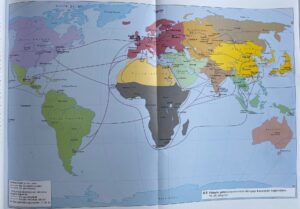
Source: Elmar Holenstein, Atlas of Philosophy
OLD MEDITERRANEAN – NEW MEDITERRANEAN
Public opinion leaders in our country always talk about the Balkans, the
Caucasus, the Middle East and the Turkic World. North Africa, Southern
Europe, Mediterranean, Eastern Europe, Northern (Russia-Ukraine),
Mesopotamia basins do not come to their minds. Altogether they are ten
basins. As long as we do not use the concept of basin, this disconnection, this
isolation will continue forever. Even though it is so on paper, even island states
are not condemned to loneliness, while peninsular countries, such as Turkey,
are stuck in loneliness.
It was my stay in Asia-Pacific for nearly five years that reinforced this idea
of basins in me. They associate the Asian continent with the Pacific,
but why is there no Asia-Mediterranean concept? The idea of basins has
brought China to today. China has started to implement the Canton
(Guangdong) model in exports, especially since 1978, and has gathered the
factories of the world to Canton. The clue here is that the factories producing
in the Canton region have concentrated their exports to these countries,
while sourcing their raw materials from the basin countries and regions. As a
result of this, an understanding of co-operation has developed in Asia-Pacific.
There are five basins in the Asia-Pacific region. East Asia, Southeast Asia,
North Asia, Greater China, Australasia.
The Asia Pacific basin is now the New Mediterranean.
Turkey is the country that can function as a dynamo in the classical
Mediterranean region in the style of the Canton model. However,
Turkey, unable to develop co-operation models, continues to spend decades
like a prodigal with artificial agendas and imposed GMEP agendas. On the other
hand, China, despite all the pressures imposed on it, continues on its way
without starving its 1.5 billion population by implementing basins and
cooperation models.
Although the Great Wall of China is physically located in the territory of the
People’s Republic of China, mentally there is a Great Wall of China in the
minds of each of the politicians, public administrators and opinion leaders in
Turkey and this mentality prevents co-operation on various occasions. The
zero zero policy with neighbours has brought Turkey to this point.
TURKISH POETRY
When we look at the map of Turkish poets outside Turkey, we see a map of
the Great Mediterranean. There are concentrations in the Balkans and
Caucasus regions. Within the definition of the Caucasus, there is also Iran
and further east, in the oases of East Turkistan, there are clusters of poets in
the easternmost city of Turfan. There is a sparse distribution in Asia.
There are concentrations in the Balkan Peninsula, which appears as a
settlement between the Mediterranean and the Black Sea, in the Crimea in
the north of the Black Sea, in the Caucasus, on the western shores of the
Caspian Sea and its hinterland, and again on the eastern Mediterranean
coast, starting from Cairo to the Turkish border.
Seasides have harboured more poets. It is essential to analyse Turkish poetry
in terms of the geographies where we have left our mark on the world. Poets
born in more than 200 cities and settlements in Europe, Asia and Africa have
written poems in Turkish.
THE GREAT SEA IN LEVEND’NÂME POEMS
Levend’nâme;
– In the Roads…
– In the Years..
. – In the Writings..
. – In the Hearts…
– In the Rows…
He brings together what we have accumulated with poetry.
Levend’âne searches after poetry in the integrity of the Great
Mediterranean formed by Turkey, which “stretches like a mare’s head to the
Mediterranean”, and Turkestan, which is surrounded by oases
LEVENDNĀME Poems take us on a journey along the shores of our Great
Mediterranean Civilisation.
We thought we would take a look at the continents, countries
and regions while following the wide geographies that we travelled but did
not disappear with poems; we came across a very rich list.
In contrast to the concept of Levantine, which refers to Eastern
Mediterraneanism, the concept of Levend’âne, which is associated with the
Greater Mediterranean concept, appeared to be inclusive of the
accumulations of around fifty countries and regions on four continents.
THE MEDITERRANEAN AND THE TURKS
The Mediterranean has been a historically, culturally and economically
important region for the Turks. Historically, the expansion and influence of
the Ottoman Empire largely extended to the Mediterranean. This region
played a critical role for the Ottoman maritime trade and strategic position.
Culturally, the different civilisations with which the Mediterranean interacted
have made various contributions to Turkish culture. Turkish settlements on
the shores of the Mediterranean have witnessed cultural exchange and
interaction throughout history.
Economically, the Mediterranean coast contributes to Turkey’s economy in
sectors such as agriculture, fisheries and tourism. At the same time, its
strategic location in terms of maritime trade and transport increases its
economic importance.
CAN TURKS REALISE UNITY IN THE MEDITERRANEAN
Turkey already has diplomatic, economic and cultural relations at various
levels with many countries in the Mediterranean region. However, Turkey’s
realisation of a full-fledged unity in the Mediterranean may be a complex
process depending on regional dynamics, political relations and the attitudes
of other countries.
For such a union, it is important to first define common interests and
objectives between the parties. In addition, existing political conflicts,
security concerns and other factors should also be taken into account.
Monitoring political developments and relations in the Mediterranean region
may help to better assess the possibility of Turkey taking such an initiative.
WHY THE MEDITERRANEAN?
In Turks, white represents the west as a direction and wisdom as a meaning.
The movement of Turks has always been in the western direction, the
meeting with Islam is also in the western direction. The meeting with Europe
is also in the west direction. The Turks travelled west, north and south from
the point where they were in Asia, but not east, because in the east was the
eternal enemy China.
The goal of a Greater Mediterranean Union is extremely meaningful in this
respect. The Organisation of Turkic States and Turkey together are moving
westwards towards the Mediterranean. However, Mediterranean countries will
also be moving eastwards towards Turkey and Turkestan. This is a
meaningful interaction. For example, the idea of the Greater Mediterranean
was planned by French President Sarkozy as a movement towards the
north, towards Europe, towards the UK, and unfortunately it was not
successful. Because there will be no movement of the UK together with
France. In this respect, it is very meaningful that the idea of the Great
Mediterranean Union is formed as a synthesis of the west and the east.
The greatest achievements of the human heritage have been realised in the
basin between the Nile River, a river flowing into the Mediterranean Sea, and
the Amuderya, the Ceyhun River of Turkestan. The cities of civilisation here
are countless; there were Roman, Sassanid, Seljuk, Khorasan and Ottoman
cities.
When Turks use the term Mediterranean in a historical context, they usually
refer to the Mediterranean coast, settlements and interactions in this region.
Due to the expansion of the Ottoman Empire and the government’s interest
in maritime trade, the Mediterranean was of strategic and economic
importance.
Furthermore, the southern coasts and coastal regions of Turkey are under the
influence of the Mediterranean climate, which means that they have a rich
potential for agriculture and tourism. These factors have been influential in
the Turks’ use of the term Mediterranean.
The Mediterranean Sea means “white sea” or “inland sea” in Turkish. This
term derives from the generally calm and clear appearance of the sea. The
Mediterranean is a vast region, including the coasts of southern Turkey, and
is of geographical, historical and cultural importance.
During the Ottoman period, Turks had established a strong influence and
dominance in the Mediterranean, especially in Anatolia, Egypt, Syria and
Arabia. With their strategic position in these lands, maritime trade and
military successes, the Ottomans had become an important power in the
Mediterranean region.
GREAT MEDITERRANEAN UNION
Turkestan is a geographically catalysing region. Turkestan, which synthesises
all aspects, includes both India and China, Islam, which came to the region
from the west, Tengricism, Shamanism and Zoroastrianism.
All these philosophies reach a synthesis, which I concluded with the following
sentence “Our most valuable underground resource is our saintly sages lying
in the lands of Turkestan”
The Greater Middle East Project is a project that does not belong to us. I look
at this map from the perspective of Greater Turkey, not the Turkic world, but
Greater Turkey. Our future will be shaped by our actions in the geography
represented by this map.
Turkey is big in Europe, Asia, Africa and all three continents.
The power in the north of Africa, in the south-east of Europe, in the interior,
west and centre of Asia is always Greater Turkey. Rather than calling these
regions by geographical names such as the Balkans, the Caucasus and
Central Asia, it is extremely important that we meet them with the concept of
Greater Turkey, which is a political characterisation.
MEDITERRANEAN
Our founding leader Mustafa Kemal Atatürk left his strategies to us. He was
the theoriser and the implementer. The greatest strategy is the idea of a
republic based on parliament. The parliament, that is, the people. But in the
process, first the name of the Turkish Army was changed to the Armed Forces
with the 27 May Coup. Then, as of 2018, the Parliament was relegated to a
secondary position. The strategy entrusted to us by our founder is the
Mediterranean strategy. But in the evil balance of Yalta, we were pushed into
the camp of the Atlantic powers. We forgot the meaning of the
Mediterranean, which means the middle of the world, and we got stuck in the
Middle East swamp, which is the strategy of the Atlanticists. We are now a
Greater Middle East country.
The Atlanticists have a grand strategy that encompasses the whole world.
We, too, have a strategy centred on the Great Mediterranean and
encompassing the whole world, which is Atatürk’s greatest trust to us. After
the idea of the Republic, which is the greatest strategy, the Mediterranean
strategy is the main one.
Continuing to be a derivative of the world politics of the Atlantic powers,
rather than developing the politics and unity of the Great Mediterranean
Union in the Mediterranean, which is the centre of the world, will have
severe consequences for our country.
COUNTRIES OF THE GREATER MEDITERRANEAN UNION
EUROPE
- Balkan 6 FTA (Free Trade Agreement)
- Black Sea 1 FTA
- Southern Europe 9 GB – EU (Customs Union – European Union)
- Eastern Europe Tunaboyu. 1. OTS (Organisation of Turkish States)
AFRICA
- North Africa 3 FTA
ASIA
- Caucasus 1 FTA
- Eastern Mediterranean 2 FTA
- Turkestan 7 OTS
Great Mediterranean 30
………………………………….
FTA (Free Trade Agreement)
List of FTAs in force
o Albania
o United Arab Emirates
o United Kingdom
o Bosnia and Herzegovina
o EFTA
o Faroe Islands
o Morocco
o Palestine
o South Korea
o Georgia
o Israel
o Montenegro
o Kosovo
o Macedonia
o Malaysia
o Egypt
o Moldova
o Mauritius
o Serbia
o Singapore
o Chile
o Tunisia
o Venezuela
13 countries Mediterranean. Caucasus Black Sea
- Balkan 6
- North Africa 3
- Caucasus 1
- Eastern Mediterranean 2
- Black Sea 1
GB – EU Southern Europe (9 countries)
- Spain
- France
- Italy
- Greece
- Bulgaria
- Croatia
- Slovenia
- Malta
- Romania
Projection of the Greater Mediterranean Union
- OTS 8
- FTA 13
- GB/EU 9
Total 30
EU 27 countries
FRANCE’S GREATER MEDITERRANEAN UNION INITIATIVE
The Great Mediterranean Union was once proposed by French President
Sarkozy, but it did not take off. I hope yours will work.
The Mediterranean Union is an initiative aimed at promoting co-operation
among the countries bordering the Mediterranean Sea. Efforts to establish
this union have varied over time. The main objectives include economic cooperation, cultural exchange, solidarity in security matters and regional
development.
Launched in 1995, the Barcelona Process laid the foundation for the
Mediterranean Union. This process aimed to develop partnership relations
between the European Union and the 12 Mediterranean countries. However,
the full operationalisation of the Union and the implementation of the projects
have faced various difficulties over time. The future of the Mediterranean
Union may change depending on the political and economic dynamics among
the member states.
The Mediterranean Union is an initiative aimed at promoting co-operation
among the countries bordering the Mediterranean Sea. Efforts to establish
this union have varied over time. The main objectives include economic cooperation, cultural exchange, solidarity in security matters and regional
development.
Launched in 1995, the Barcelona Process laid the foundation for the
Mediterranean Union. This process aimed to develop partnership relations
between the European Union and the 12 Mediterranean countries. However,
the full operationalisation of the Union and the implementation of the projects
have faced various difficulties over time. The future of the Mediterranean
Union may change depending on the political and economic dynamics among
the member states.
Nicolas Sarkozy’s Mediterranean Union initiative came to the fore during the
French presidency of the European Union in 2008. However, this initiative has
caused some criticism and controversy. The union proposed by Sarkozy
aimed to promote co-operation among the countries bordering the
Mediterranean. However, some countries, especially some Arab countries,
saw this initiative more as a French influence and criticised it.
Therefore, Sarkozy’s initiative was not fully successful and did not achieve the
planned objectives. However, efforts such as the Barcelona Process, which
laid the foundation for the Mediterranean Union, have continued in regional
cooperation and dialogue.
CONCLUSION:
Fatih started the conquest of the Mediterranean from the mountains of
Albania. When Mustafa Kemal Atatürk, the founder of the Republic of
Turkey, gave the order to attack the enemy on 26 August 1922, he used an
expression that transcends time.
“Your first objective is the Mediterranean. Forward!”
After his death and in the years following the Second World War, this goal
was revised by his followers as Atlantic. Now we have to turn again towards
the goal that Atatürk showed us.
Integration and integration efforts such as the EU, BSEC, D8, ECO are
attempts that have been defunct through stalling. The cornerstone of the
“Asian Millennium” we are in is the “Greater Mediterranean”. Our country
has taken the first concrete step in this regard by establishing the
Organisation of Turkic States. Now it is time to expand the cooperation
between Turkey and Turkestan countries towards the Mediterranean
countries.
The geographies of Turkey and Turkestan show a unity of unique value and
together with the route and traffic to the Mediterranean via the Silk Road,
they constitute a triple cooperation ground.
As a first step in the “Greater Mediterranean” vision, we can initiate
integration by associating Libya with the Organisation of Turkish States.
As a generation whose ancestors sailed in the Mediterranean waters, a new
and modern cooperation, reunification and integration task awaits us.
Since the Caspian Sea is on the north-south axis and the Mediterranean Sea is on
the west-east axis, the coefficient of expansion is higher. The Americans created
the concepts of Greater China and Greater Middle East.
We Turks, on the other hand, can unite the sub-basins (Balkans, North Africa,
Levant, Caspian, Turkestan, Indian Subcontinent) by producing the concept of the
Great Mediterranean.
MEDITERRANEAN WRITINGS [12]
References
- Poet-Thinker. 40 years export professional. He lived in Hong Kong
between 1997-2001; he always heard the footsteps of the upcoming
Great Asian Century. Ismail Gaspıralı’s ideal of “Unity in Language, Idea
and Work”, he is working on a series of books[1] ; he is writing down his
observations and experiences as an intellectual and entrepreneur. He
has adopted the motto of sleeping with ideas and getting up with poetry.
Contact: [email protected]
- https://hayatitek.com/rusya-cin-ve-turkler/
- https://1000kitap.com/gonderi/172859053?oku=1
- https://www.agaoglulevent.com/ipek-yolu-guzergahi/
- https://www.booksonturkey.com/buyuk-akdeniz-bilgeleri/
- https://leventagaoglu.blogspot.com/2019/04/kayp-aydnlanma-ortaasyann-altn-cag.html
- https://www.booksonturkey.com/pusulamiz-kuzey-atlantik-natosumu-renkli-denizlermi/
- Eurasia One Foundation – Prof. Dr. Mehmet Akif Okur Conference. 10
November 2018
- https://it.wikipedia.org/wiki/Tullia_Romagnoli_Carettoni
10.İlber Ortaylı: “The Turkish World is the Synthesis of East and West” |
Workshop on State Accumulation in Asia. 19 November 2023
11.İlber Ortaylı: “The Turkish World is the Synthesis of East and West” |
Workshop on State Accumulation in Asia. 19 November 2023
12.https://www.booksonturkey.com/akdeniz-yazilari/


